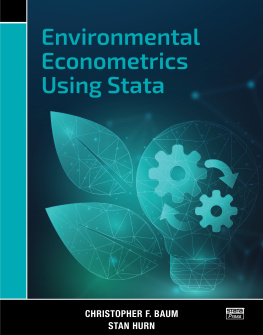We assume that you have studied basic math. Hopefully you understand the calculus concepts of differentiation and integration, though these tools are not required prerequisites for success using this book. In this appendix we review some essential concepts that you may wish to consult from time to time.
can be represented by points on a line. There are an uncountable number of real numbers, and they are not all rational. Numbers such as 3.1415927 and 2 are said to be irrational since they cannot be expressed as ratios, and have only decimal representations. Numbers like 2 are not real numbers. The of a number is denoted by |a| . It is the positive part of the number: |3| = 3 and |3| = 3 .
among numbers obey certain rules. The notation a < b , a is less than b, means that a is to the left of b on the number line, and that b a > 0 . If a is less than or equal to b, it is written as ab. Three basic rules are
Ifa
0ac>bcifc<0IfaA.1.2 Exponents
are defined as follows:
xn = xxx (n terms) if n is a positive integer
x0 = 1 if x 0 . 00 does not have meaning and is undefined.
Some common rules for working with exponents, assuming x and y are real, m and n are integers, and a and b are rational, are as follows:
xn=1xnifx0.For example,x1=1xx1/n=xn.For example,x1/2=xandx1/2=1xxm/n=x1/nm.For example,84/3=81/34=24=16xaxb=xa+b,xaxb=xabxya=xaya,(xy)a=xaya
A.1.3 Scientific Notation
is useful for very large or very small numbers. A number in scientific notation is written as a number between 1 and 10 multiplied by a power of 10. So, for example: 5.1 105 = 510, 000 , and 0.00000034 = 3.4 107 . Scientific notation makes handling large numbers much easier, because complex operations can be broken into simpler ones. For example,
510,0000.00000034=(5.1105)(3.4107)=(5.13.4)(105107)=17.34102=0.1734
and
510,0000.00000034=5.11053.4107=5.13.4105107=1.51012
Computer programs sometimes write 5.1 105 = 5.1E5 or 5.1D5 and 3.4 107 = 3.4E7 or 3.4D7 .
A.1.4 Logarithms and the Number e
Logarithms are exponents. If x = 10b, then b is the . All logarithms in this book are natural logarithms. We express the natural logarithm of x as ln(x),
For any positive number, x > 0,
elnx=explnx=x
and
lnex=x
Note that ln (1) = 0 , using the laws of exponents. gives the logarithms of some powers of 10. For example, e2.3025851 = 10 and e4.6051702 = 100 .
Some Natural Logarithms
| x | ln(x) |
| 1 | 0 |
| 10 | 2.3025851 |
| 100 | 4.6051702 |
| 1,000 | 6.9077553 |
| 10,000 | 9.2103404 |
| 100,000 | 11.512925 |
| 1,000,000 | 13.815511 |
Note that logarithms have a compressed scale compared to the original numbers. Since logarithms are exponents, they follow similar rules:
lnxy=lnx+lnylnx/y=lnxlnylnxa=alnx
For example, if x = 1000 and y = 10, 000 , then
ln100010,000=ln1000+ln10,000=6.9077553+9.2103404=16.118096
What is the advantage of this? The value of xy is a multiplication problem, which by using logarithms we can turn into an addition problem. We need a way to go backward, from the logarithm of a number to the number itself. By definition,
x=elnx=explnx
When there is an , because we can recover the value of x using it. Then,
100010000=exp16.118096=10,000,000
You will not be doing many calculations like these, but the knowledge of logarithms and exponents is quite critical in economics and econometrics.
A.1.5 Decimals and Percentages
Suppose the value of a variable y changes from the value y = y0 to y = y1 . The difference between these values is often denoted by y = y1y0 , where the notation y is read change in y, or delta-y. The in y is defined to be
(A.1) relative changeiny=y1y0y0=yy0
For example, if y0 = 3 and y1 = 3.02 , then the relative change in y is
y1y0y0=3.0233=0.0067
Often the relative change in y is written as y/y , omitting the subscript.
A relative change is a decimal. The corresponding in y is 100 times the relative change.
percentage changeiny=100y1y0y0=%y
If y0 = 3 and y1 = 3.02 , then the percentage change in y is
%y=100y1y0y0=1003.0233=0.67%
A.1.6 Logarithms and Percentages
A feature of logarithms that helps greatly in their economic interpretation is that they can be approximated very simply. Let








